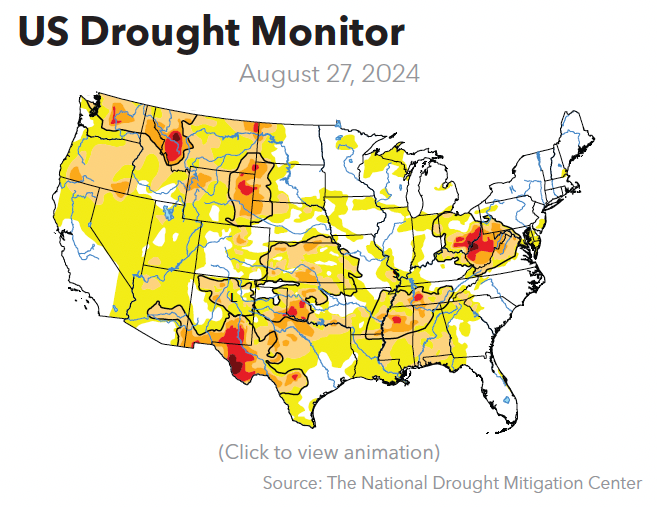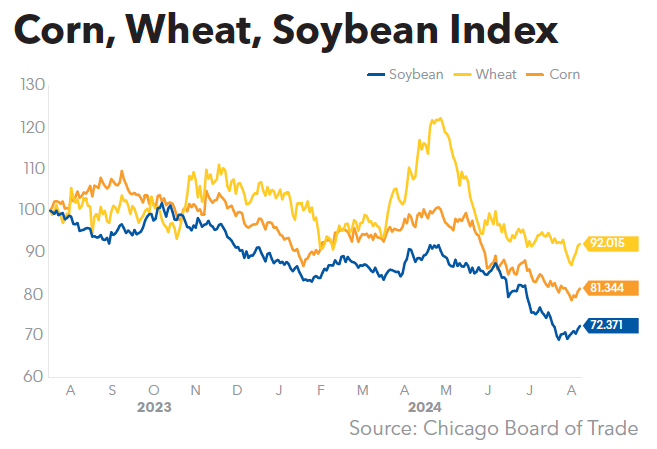Eastern Cornbelt:
High heat and humidity blanketed much of the Eastern Cornbelt during the week, with heat advisories in effect for multiple locations and heat index readings climbing to 105-110 degrees in parts of Illinois and Indiana.
Northern Ohio also experienced intense late summer heat, with highs on Aug. 29-30 reaching the low-90s and heat indices touching the upper-90s. Scattered showers were in the region’s forecast for the Labor Day weekend, however.
USDA on Aug. 25 reported that 9-10% of the corn crop in Illinois and Indiana was mature, with good or excellent rating assigned to 73% of the acreage in Illinois, 71% in Indiana, 66% in Michigan, and 49% in Ohio. Soybeans in the good or excellent categories totaled 71% of the crop in Indiana, 64% in Illinois, 62% in Michigan, and 48% in Ohio.
Western Cornbelt:
Strong thunderstorms pushed through northeastern Missouri and southeastern Iowa on Aug. 27, causing wind and hail damage in Burlington, Iowa, and Rutledge, Mo. Rainfall totals of 2-4 inches were reported in some areas, along with 70-80 mph winds. Hailstorms also battered parts of central Nebraska on Aug. 26.
The storms were preceded by sweltering heat, with daily record highs in the mid- to upper-90s reported in multiple locations across the region.
Good or excellent ratings were assigned to 77% of the corn and soybeans in Iowa on Aug. 25, compared with 75-78% in Missouri and 68-71% in Nebraska. Missouri’s rice and cotton were 71% and 57% good or excellent, respectively, while 77% of Nebraska’s sorghum crop fell into those two categories on Aug. 25.
Southern Plains:
Much of the Southern Plains baked under sweltering heat for most of the week, though showers and cooler temperatures were on tap for the Labor Day weekend. Highs were expected to dip to the 70s and 80s by the weekend, down from the mid- to upper-90s.
Earlier in the week, strong thunderstorms dropped 1-3 inches of rain in just three hours in parts of central Texas. New Mexico was bracing for potentially heavy rain on Aug. 29-30, with forecasts warning of flash flooding in the Sangre de Cristo Mountains.
Crop conditions continued to show the effects of drought in the region. Just 26% of Texas cotton was rated as good or excellent as of Aug. 25, compared with 45% in Oklahoma and 55% in Kansas. The Kansas soybean crop was 60% good or excellent, while just 45% of the state’s corn fell into those two categories, compared with 41% in Texas and 38% in Colorado.
The Texas sorghum crop was 67% harvested by Aug. 25, with good or excellent ratings assigned to 47% of the acreage, compared with 42% in Kansas, 52% in Colorado, and 59% in Oklahoma.
South Central:
Scattered showers and thunderstorms in Arkansas and Tennessee on Aug. 29 also brought cooler weather after intense heat earlier in the week. Heat advisories were in effect at midweek for portions of eastern Arkansas, northern Mississippi, Kentucky, and western Tennessee, with highs reported in the mid- to upper-90s.
Good or excellent ratings were assigned to 67% of Kentucky corn crop on Aug. 25, compared with 49% in Tennessee, with 25-36% of the crop rated as mature in those two states. Soybeans in the good or excellent categories totaled 73-74% of the acreage in Arkansas and Louisiana, 60% in Kentucky and Mississippi, and 51% in Tennessee.
Fully 78% of the Arkansas cotton crop was rated as good or excellent, compared with 69% in Louisiana and 51-53% in Tennessee and Mississippi. With the rice harvest now 80-84% complete in Louisiana and Texas and 23% in Arkansas and Mississippi, USDA placed 84% of Louisiana’s crop in the good or excellent categories, along with 76% of the acreage in Arkansas, 58% in Mississippi, and 54% in Texas.
Southeast:
Highs in the upper-90s and low-triple digits were common across much of the Southeast during the week, prompting heat advisories and sparking thunderstorms that were severe in some areas. A flood watch was in effect on Aug. 28 for parts of Virginia after storms unleashed 2-4 inches of rain within an hour or two.
Crop conditions varied considerably in the region in late August. While just 11% of North Carolina’s corn was rated as good on Aug. 25, 55% of the state’s soybean crop was rated as good or excellent on that date. Cotton in the good or excellent categories totaled 71% of the acreage in Virginia, 68% in North Carolina, 56% in Alabama and Georgia, and 48% in South Carolina.
The peanut crop was 90% good or excellent in Virginia, compared with 77% in North Carolina, 68% in Alabama and Florida, 62% in Georgia, and 60% in South Carolina.

